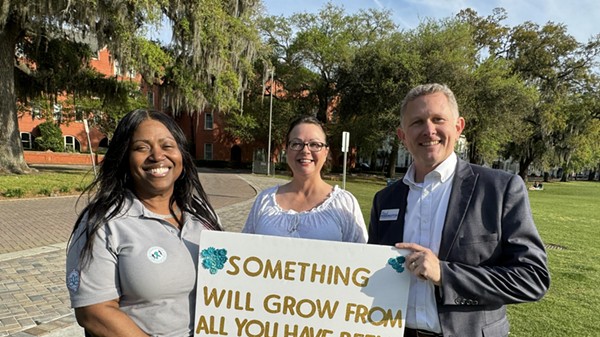Georgia is blessed by nature with remarkable water resources — and I'm not just talking about the ocean off our coast and its brackish cousin that hosts and invigorates our salt marsh.
Vast amounts of freshwater gather through the years in underground limestone aquifers under our feet. These legacies of ancient rainfalls are in turn recharged by new precipitation, seeping gradually into the earth as the centuries roll by.
The great Floridan Aquifer and others like it once fueled artesian wells throughout the region. Back in the day, you could sink a shallow well just about anywhere and instantly have all the freshwater you wanted.
Technically it's a renewable resource, but... in practice not so much.
As blessed as we are, we've also been cursed with a historic inability to responsibly steward this precious resource. This goes back to one of Georgia's first boom industries, the gold rush of the 1830s.
Turns out the area of north Georgia near Dahlonega boasts — or once boasted — one of the largest, most pure, and easily accessible veins of gold in the world. So accessible, legend has it that early prospectors literally tripped over large gold nuggets.
These two then-plentiful resources — water and gold — soon came together to write an awful story of environmental and human degradation.
As word spread about the Dahlonega vein, those scattered nuggets were quickly scooped up, as were the ones you could easily pan in mountain creeks. But the greed remained. A new branch of the U.S. Mint in Dahlonega, built especially for the Georgia gold rush, had to be fed.
So a new, horribly ingenious way was found to rape the earth for the increasingly harder-to-find Georgia gold: Massive water hoses literally blasted away entire mountainsides. The detritus was gathered behind dams which were then blown open, the resulting slurry of former mountainside pouring down to processing facilities.
The environmental cost: Scars all across the supposedly "pristine" mountains of north Georgia, visible to this day.
The human cost: The Trail of Tears, as thousands of Cherokee men, women, and children were forced off their ancestral land to make way for gold claims awarded by lottery.
A century later the paper mills came to Georgia. Almost as soon as the huge, thirsty Union Bag plant — now International Paper — opened in Savannah along with others along the coast, the freshwater table receded dramatically, tens of feet virtually overnight as the mills voraciously sucked the aquifer in ways nature never intended.
Today, our Floridan Aquifer is a shadow of its former self. Ocean saltwater intrusion due to decreased freshwater pressure is well underway, and once an aquifer salts out, it's useless to humans. Forever.
The City of Savannah water department has quietly, but ominously, moved to a "blend" of groundwater and treated river water for residential customers, while the paper plant continues to have unfettered free use of the aquifer itself.
A profligate heir to Georgia's callousness toward natural resources is the Georgia Power nuclear facility just up the Savannah River, Plant Vogtle. The problem is not only the fact that the new upgrade to Plant Vogtle is a rip-off to ratepayers — special legislation allowed Georgia Power to recoup construction costs up front, out of our pockets.
Another problem is that nuclear plants need massive amounts of freshwater to cool their reactors, in this case river water which will be increasingly important for household use in the wake of the great primordial aquifer die-off.
And make no mistake, the aquifers are dying. A new U.S. Geological Survey report shows the Floridan Aquifer has receded as much as 18 feet in some areas, due to increased pumping and low rainfall. Other aquifers are at least as bad: 22 feet lost in the Claiborne Aquifer, 17 in the Cretaceous, and a whopping 30 feet in the Clayton Aquifer.
Meanwhile, a new gold rush in north Georgia is again stressing water resources: Fracking.
Heralded as the main reason for the resurgence in the U.S. energy sector, fracking also uses a crap ton of water — indeed, huge amounts of water are what causes the shale fracturing inherent in the name.
Fracking in the U.S. already uses the same amount of water as two major metro areas, a stat which will only get worse before it gets better, given fracking's relative newness.
The common thread is this: All these industries — whether gold, paper, or energy — never seem to pay the price for profligacy. Free resources are as free to them as to us, but they use so much more of it on a daily basis, and are only rarely held accountable.
But there's another free resource that really is unlimited in supply. On a clear day, it literally stares us in the face.
You'd think solar energy would be a part of Georgia's collective energy plan moving forward. You'd think wrong.
As detailed by Chrystal Arboleda Lopez's excellent debut for us in this issue, Georgia Power's 20-year "Integrated Resource Plan" seems to have little integration, and indeed maybe isn't much of a plan.
There's virtually no mention of solar energy in it.
While certainly it's good news that 15 coal-fired plants will be shut down, many will just be replaced by natural gas facilities fueled in large part by fracking.
In the 20 years covered by Georgia Power's plan, a whole new generation of Georgians will be born and grow to voting age.
Maybe those new voters will finally be able to vote out industry-favoring members of the Georgia Public Service Commission.
Maybe they'll replace them with members who'll force industries to pay a fair price for the resources they use up in such great quantity.
And maybe, just maybe, even force them to plan more responsibly for the future — if it's not too late by then.



























